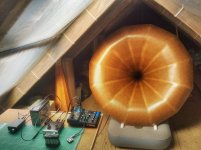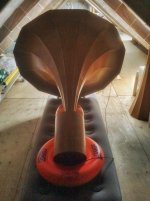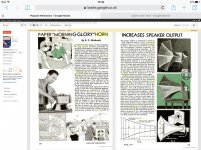Hello all,
I have reached the end of a 300 hour build of a (mono) Le Cleach type front loaded horn just over 4ft in width with a mouth exit curve of 112 degrees. It has both back and front chambers, and as a prototype, I consider it a relative success - for now.
It was modelled in Hornresp around a 6.5in Visaton BG17 (full range with a whizzer) and also a 6.5in Jensen guitar speaker. Why these? Because I had them already, and they are cheap enough to thrash and trash.
At first, the Visaton seemed quite nice, but I suspect the whizzer does not perform very well inside the compression chamber. Somewhat congested, and a bit shrill. It lacks bass, and although lively, it is quite tiring on the ear. The Jensen has much better bass, mids seem nice enough, but lacks clarity in the treble. Both drivers benefit from the use of EQ, and although I love to sit and listen and sing and dance in front of this massive horn, I feel that there is a much greater potential for musical joy as yet untapped.
There does not seem all that much to choose from out there for 6 to 6.5in full range drivers. However, I have read about the 6in MarkAudio Alpair 10M Gen 3. Its physical spec suggests that it would easily fit without having to modify the existing enclosure. My question is, would this driver be suitable for a front loaded horn? And, with its long throw design, would it give a decent amount of bass without an excessive use of EQ?
For what it is worth, I am a practicing artist working with vision and sound, and although technically accomplished, I am NOT an audiophile. My taste in music is, shall we say, eclectic. So long as it engages my emotions, I will listen to anything. As for builders passion, it is horns for me - magical and beautiful.
I would truly appreciate some help with this.
Kindness tapestryofsound
I have reached the end of a 300 hour build of a (mono) Le Cleach type front loaded horn just over 4ft in width with a mouth exit curve of 112 degrees. It has both back and front chambers, and as a prototype, I consider it a relative success - for now.
It was modelled in Hornresp around a 6.5in Visaton BG17 (full range with a whizzer) and also a 6.5in Jensen guitar speaker. Why these? Because I had them already, and they are cheap enough to thrash and trash.
At first, the Visaton seemed quite nice, but I suspect the whizzer does not perform very well inside the compression chamber. Somewhat congested, and a bit shrill. It lacks bass, and although lively, it is quite tiring on the ear. The Jensen has much better bass, mids seem nice enough, but lacks clarity in the treble. Both drivers benefit from the use of EQ, and although I love to sit and listen and sing and dance in front of this massive horn, I feel that there is a much greater potential for musical joy as yet untapped.
There does not seem all that much to choose from out there for 6 to 6.5in full range drivers. However, I have read about the 6in MarkAudio Alpair 10M Gen 3. Its physical spec suggests that it would easily fit without having to modify the existing enclosure. My question is, would this driver be suitable for a front loaded horn? And, with its long throw design, would it give a decent amount of bass without an excessive use of EQ?
For what it is worth, I am a practicing artist working with vision and sound, and although technically accomplished, I am NOT an audiophile. My taste in music is, shall we say, eclectic. So long as it engages my emotions, I will listen to anything. As for builders passion, it is horns for me - magical and beautiful.
I would truly appreciate some help with this.
Kindness tapestryofsound
A good question.
But do note that the Alpair 10x is a 5.25” driver.
In the interest of fitting, the Alpair 12p is a 6.5” driver.
dave
Hi Dave,
Thank you for that, my dilemma is that the compression well in which the driver has to sit is 165mm (that is) 6.5inches in diameter. And so the Alpair 12p in my case would be way too big .....Anyway, I hear you often talk about the excellent bass response that the MarkAudio drivers are capable of. Do you think the Alpair 10x at 5.25in could work for me?
Kindness tapestryofsound
I’ll leave that to Scott to answer. It is not designed for front horn loading, and the lift in the lower ranges would need to be EQed out so that the higher frequencies where the horn unloads would not be overwhelmed.
dave
Yes, I hear what you say. Apart from Lowther, there does not seem to be many drivers out there specifically designed for use in front loaded horns. Of course, I may well be wrong. So far, where I have gotten to sounds pretty good - for now, but I would like to eventually settle on something that works well with no EQ at all.
When I had the Visaton installed, the EQ, from song to song, was all over the place. My imagination kept telling me there was a donut of compressed air trapped under the whizzer that would resonate, thus disturbing the mix between bass and treble. I do believe the solution is in remodelling the actual shape of the compression chamber where it meets the entrance to the throat. And of course, I may be wrong on that too!
tapestryofsound
You mean conventional (paper) cone drivers - there are of course compression drivers of all sizes and material types built for that purpose.
Thank you chrisb, I have thought a lot about using compression drivers ...... and the very good ones can be very expensive, but so can paper cone speakers
When I started my prototype build, I decided to make as many problems for myself as possible. Firstly, size - 48 inches wide is about the limit of my manual dexterity. Such a large size also means a fairly good chance of useable bass without the intervention of a subwoofer, for I am fascinated by the idea of music presented by a full range single point sound source. Secondly, weight - a cello can be picked up by one hand. I can pick up my build with one hand. A cello has a coloured sound, so has my build. I like to think it's colour is inherently musical - like a cello, or a piccolo for that matter. And thirdly, beauty of sound that can be listened to effortlessly and endlessly and still wanting more - this is proving the hardest of all to achieve, and the choice of driver is the stumbling block.
But, back to compression drivers. I have spent a lot of time looking at John Inlow's website and studying his particular approach to building horns, which I must point out is quite unlike mine. He claims that with the better 2inch JBL compression drivers it is possible, with sufficient EQ, to get good useable bass down to around 100hz, or so, and dispense with a tweeter altogether. I believe him, but the JBL's are not cheap, and I am wondering if it is at all possible to find 2inch compression drivers at a reasonable price that don't hurt the ears. I do not rule out the use of a sub bass, and I do understand the three octave yardstick as applies to horns, but there is a stubborn part of me that wants to try to get it all working in one!
Here is a picture of my build

tapestryofsound
Here is another picture of my build, taken two weeks ago. It is 4ft long by 4ft wide, made entirely of paper and card, and is light enough to lift with one hand. It is also immensely strong.
I would like to emphasise that my research and development work and all of the processes that I use, are entirely within the public domain.
I would like to emphasise that my research and development work and all of the processes that I use, are entirely within the public domain.
Attachments
Today I had a close look at the spec sheet for the Alpair 10P G1 and 10M G3. Turns out that the bezel heights makes it all a bit too congested in the compression chamber for the cone to travel properly. Looks like I would have to design and build an enclosure specially for any one of the MarkAudio drivers, and I'm good with that - but later. Guess I have answered my own question
As it is, I built my horn speaker for the 6.5in Jensen guitar speaker, and I'm still finding out exactly what on Earth I have created. Today, I took delivery of an anglers folding canvas stool, which measures up exactly to suspend the horn at its fulcrum of balance, so that the front lip of the horn clears the floor by about an inch. It tilts everything ever so slightly up to meet the sweet spot around 15ft away. When I play music, the whole structure resonates and colours the sound beautifully. The bass has suddenly become visceral, and the actual sensation of music in the room is now palpable. It feels like the breath that rises up from a waterfall.
Anyway, thank you all for taking an interest, looks like I'm done here. Time to logout and do other things.
Kindness tapestryofsound
As it is, I built my horn speaker for the 6.5in Jensen guitar speaker, and I'm still finding out exactly what on Earth I have created. Today, I took delivery of an anglers folding canvas stool, which measures up exactly to suspend the horn at its fulcrum of balance, so that the front lip of the horn clears the floor by about an inch. It tilts everything ever so slightly up to meet the sweet spot around 15ft away. When I play music, the whole structure resonates and colours the sound beautifully. The bass has suddenly become visceral, and the actual sensation of music in the room is now palpable. It feels like the breath that rises up from a waterfall.
Anyway, thank you all for taking an interest, looks like I'm done here. Time to logout and do other things.
Kindness tapestryofsound
Here is another picture of my build, taken two weeks ago. It is 4ft long by 4ft wide, made entirely of paper and card, and is light enough to lift with one hand. It is also immensely strong.
I would like to emphasise that my research and development work and all of the processes that I use, are entirely within the public domain.
That is a beautiful horn. Nice work
I've tried to make petal horns work with a cone driver with limited success. Are you doing any sims in parallel with your work ?
Last edited:
That is a beautiful horn. Nice work
I've tried to make petal horns work with a cone driver with limited success. Are you doing any sims in parallel with your work ?
Hi DonVK, why thank you for that
Not entirely sure by what you mean by way of sims, but what I do use, is Hornresp. Let's just say that David McBean is a real dude, we are not worthy, and Hornresp is a truly fantastic piece of software. Although I can and do appreciate mathematical beauty in all its forms, the mechanics are way beyond my intellectual capacity. It took me a long time to understand Hornresp's parameters, months in fact, and as they say, Google became my best friend. I find the best approach is to treat Hornresp as a handful of scratch cards with infinite possibilities. You never know what you are going to get, so keep on hitting the save function. In the end, it took me nearly a month of hitting on it every day before I got something I felt I could commit to. It really all depends upon the driver, and the most expensive is not necessarily the best. My advice is to download driver spec sheets, enter the T & S's and see what happens. Hornresp is not an oracle, but it comes pretty darn close.
A common piece of folkloric wisdom is that a front loaded horn can only handle three octaves. Well, that may be true of compression drivers, but paper cones? Nope, and there is very little out there in the public domain to say otherwise. What I do know (so far) is that a big horn will give a big soundstage with a lot more than three octaves.
And if you haven't the room for a stereo pair, a big mono horn is still darn good, and I can listen to mine all day long.
tapestryofsound
That is an incredibly beautiful horn. I would love to learn/see more about your process and materials.
Hi pcgab, I have thought about your question, and this my answer.
If I give you the whole box of toys, you will get bored, and throw the lot out of the pram. This is DIY as in doing it for yourself - not - doing it as somebody tells you how. So I will give you one wonderful toy that you can keep for yourself. It is from Popular Mechanics, it is from within the public domain, and it really will work. If you do this for yourself, it will be so much fun, and all kinds of good things will spin off from it.
Ideas spawn techniques.....and this one is on me ......
tapestryofsound
Attachments
Ideas spawn techniques.....and this one is on me ......
tapestryofsound
I couldn't agree more, thank you very much!
It is 4ft long by 4ft wide, made entirely of paper and card, and is light enough to lift with one hand.
That's a bit of a worry
That's a bit of a worry. Are the horn walls well damped? Do they sound "acoustically dead" when tapped?
Ohhhhh, nuance of meaning here
 If I tap a lump of lead it's 'dum' if I tap a piece of mdf it's 'donk' if I hit a piece of plywood it's 'dank' if I tap my horn it's 'doonk'. So, I guess its acoustic is lively-ish, like a cello or a double bass.
If I tap a lump of lead it's 'dum' if I tap a piece of mdf it's 'donk' if I hit a piece of plywood it's 'dank' if I tap my horn it's 'doonk'. So, I guess its acoustic is lively-ish, like a cello or a double bass.Put it this way, at a reasonable listening volume, I can hear the colouration of the horn blending and shaping the timbre of the music - and - if I suddenly cut the signal from the amp, there is no ringing or decay of sound within the structure. Believe me, I thought a lot about this aspect during my build, and although I have respect and admiration for those who build 3-4-500lb horns, I would dread to have one fall on me, and at least, if I want to, I can gig with my pop-up battery powered hornspeaker.
So, to answer your question, I believe the horn to be not so much 'acoustically dead' but alive and well
tapestryofsound
I’ll leave that to Scott to answer. It is not designed for front horn loading, and the lift in the lower ranges would need to be EQed out so that the higher frequencies where the horn unloads would not be overwhelmed.
dave
FWIW, most wide range point source drivers require a parabolic flare to minimize this, so to go low requires a higher Qts than typical horn flares.
GM
FWIW, most wide range point source drivers require a parabolic flare to minimize this, so to go low requires a higher Qts than typical horn flares.
GM
Until now, a high Qts was something that I was completely unaware of. I tried a Visaton BG17 full ranger with a Qts of 0.74 and not much bass. Then I settled on a Jensen MOD 6 guitar speaker with a Qts of 1.23 and got substantially more bass. With EQ of +15db @ 100hz I get bass than can be felt. Top end seems to look after itself.
Having looked at the Jensen MOD 8 spec sheet, it has a Qts of 2.24 with a sound described as 'bass loose, mids firm, highs sweet' and a sensitivity of 93.2db.
Perhaps a MOD 8 is a driver I should seriously consider for my next build.
tapestryofsound
A common piece of folkloric wisdom is that a front loaded horn can only handle three octaves. Well, that may be true of compression drivers, but paper cones? Nope, and there is very little out there in the public domain to say otherwise. What I do know (so far) is that a big horn will give a big soundstage with a lot more than three octaves.
And if you haven't the room for a stereo pair, a big mono horn is still darn good, and I can listen to mine all day long.
tapestryofsound
That's my experience so far. I can get flattish 2 octave response using a horn and cone driver but if I want wider I need EQ to get it.
Have you measured the response of yours ?
- Status
- This old topic is closed. If you want to reopen this topic, contact a moderator using the "Report Post" button.
- Home
- Loudspeakers
- Full Range
- Suitability of Alpair 10M Gen 3 For Front Loaded Horn

